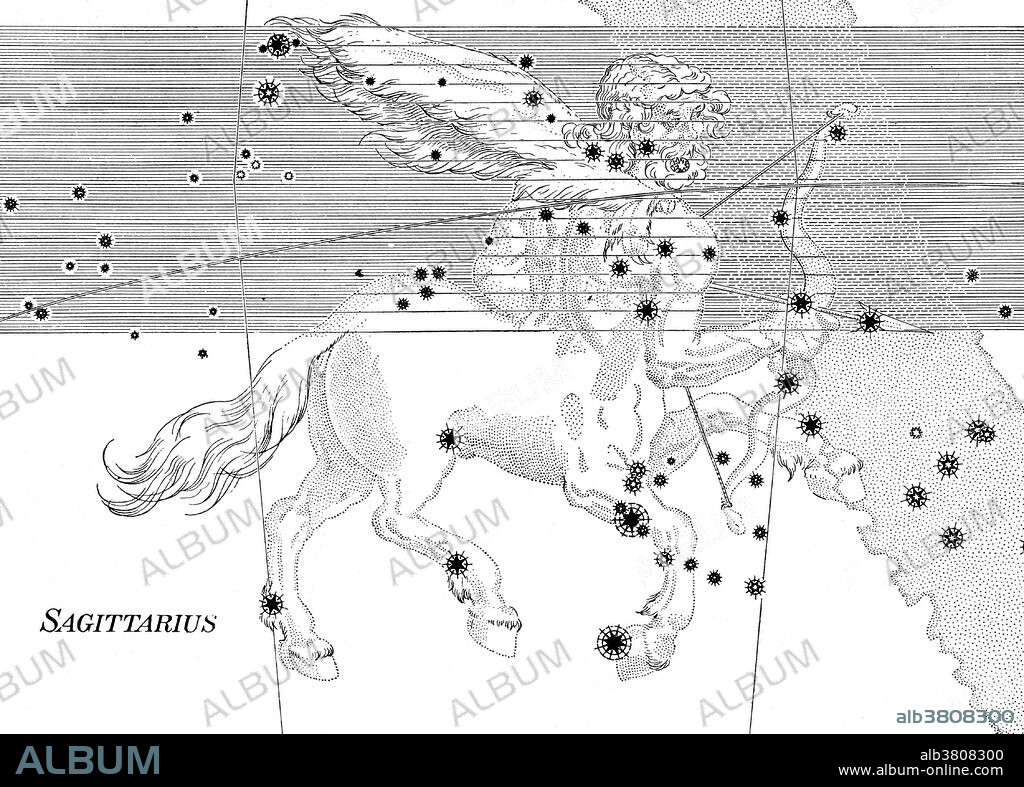alb3808300
Sagittarius Constellation, Zodiac Sign, Bayer

|
Add to another lightbox |
|
Add to another lightbox |



Title:
Sagittarius Constellation, Zodiac Sign, Bayer
Caption:
Sagittarius constellation from Johann Bayer's star atlas Uranometria Omnium Asterismorum, 1603. Sagittarius is a constellation of the zodiac, the one containing the galactic center. Its name is Latin for the archer. It is one of the 48 constellations described by the 2nd century astronomer Ptolemy, and remains one of the 88 modern constellations defined by the International Astronomical Union. Sagittarius is commonly represented as a centaur drawing a bow. It lies between Ophiuchus to the west and Capricornus to the east. In Greek mythology, Sagittarius is identified as a centaur: half human, half horse. Sagittarius is the ninth astrological sign, which is associated with the constellation Sagittarius. It spans the 240-270th degree of the zodiac, between 234.75 and 270 degree of celestial longitude, which the Sun transits on average between November 23 to December 21 each year. Johann Bayer's star atlas Uranometria Omnium Asterismorum was the first atlas to cover the entire celestial sphere. The Uranometria introduced a new system of star designation which has become known as the Bayer designation. His atlas added 12 new constellations to fill in the far south of the night sky, which was unknown to ancient Greece and Rome.
Credit:
Album / Science Source / New York Public Library
Releases:
Model: No - Property: No
Rights questions?
Rights questions?
Image size:
4500 x 3226 px | 41.5 MB
Print size:
38.1 x 27.3 cm | 15.0 x 10.8 in (300 dpi)
Keywords:
1603 • 17TH CENTURY • ARCHER, THE • ART • ARTWORK • ASTERISM • ASTROLOGICAL • ASTROLOGY • ASTRONOMICAL • ASTRONOMY • BAYER • BW • CELEBRITIES • CELEBRITY • CELESTIAL BODY • CELESTIAL SPHERE • CELESTIAL • CENTAUR • CENTAURS • CENTAURUS • CONSTELLATION • DRAWING • ENGRAVING • FAMOUS • HEAVENLY BODY • HEAVENLY • HISTORIC • HISTORICAL • HISTORY • HOROSCOPE • ILLUSTRATION • ILLUSTRATIONS • IMPORTANT • JOHANN BAYER • MYTHOLOGICAL ANIMAL: CENTAUR • NOTABLE • OCCULT • PATTERN OF STARS • SAGITTARIUS • SCIENCE • SIGNS OF THE ZODIAC • SIGNS • STAR ATLAS • STAR CHART • STAR MAP • URANOMETRIA OMNIUM ASTERISMORUM • URANOMETRIA • WELL-KNOWN • ZODIAC • ZODIACAL
 Pinterest
Pinterest Twitter
Twitter Facebook
Facebook Copy link
Copy link Email
Email

